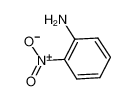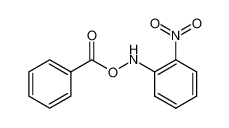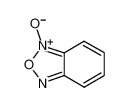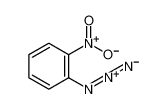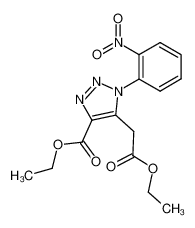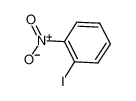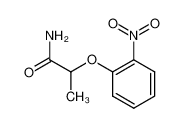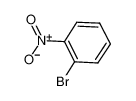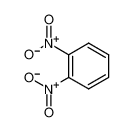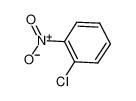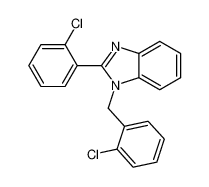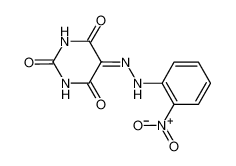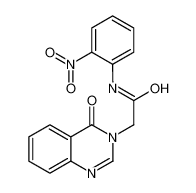1.Identification
1.1 GHS Product identifier
| Product name | 2-nitroaniline |
|---|
1.2 Other means of identification
| Product number | - |
|---|---|
| Other names | o-Nitraniline |
1.3 Recommended use of the chemical and restrictions on use
| Identified uses | For industry use only. |
|---|---|
| Uses advised against | no data available |
1.4 Supplier's details
| Company | MOLBASE (Shanghai) Biotechnology Co., Ltd. |
|---|---|
| Address | Floor 4 & 5, Building 12, No. 1001 North Qinzhou Road, Xuhui District, Shanghai, China |
| Telephone | +86(21)64956998 |
| Fax | +86(21)54365166 |
1.5 Emergency phone number
| Emergency phone number | +86-400-6021-666 |
|---|---|
| Service hours | Monday to Friday, 9am-5pm (Standard time zone: UTC/GMT +8 hours). |
2.Hazard identification
2.1 Classification of the substance or mixture
Acute toxicity - Oral, Category 3
Acute toxicity - Dermal, Category 3
Acute toxicity - Inhalation, Category 3
Specific target organ toxicity – repeated exposure, Category 2
Hazardous to the aquatic environment, long-term (Chronic) - Category Chronic 3
2.2 GHS label elements, including precautionary statements
| Pictogram(s) |   |
|---|---|
| Signal word | Danger |
| Hazard statement(s) | H301 Toxic if swallowed H311 Toxic in contact with skin H331 Toxic if inhaled H373 May cause damage to organs through prolonged or repeated exposure H412 Harmful to aquatic life with long lasting effects |
| Precautionary statement(s) | |
| Prevention | P264 Wash ... thoroughly after handling. P270 Do not eat, drink or smoke when using this product. P280 Wear protective gloves/protective clothing/eye protection/face protection. P261 Avoid breathing dust/fume/gas/mist/vapours/spray. P271 Use only outdoors or in a well-ventilated area. P260 Do not breathe dust/fume/gas/mist/vapours/spray. P273 Avoid release to the environment. |
| Response | P301+P310 IF SWALLOWED: Immediately call a POISON CENTER/doctor/… P321 Specific treatment (see ... on this label). P330 Rinse mouth. P302+P352 IF ON SKIN: Wash with plenty of water/... P312 Call a POISON CENTER/doctor/…if you feel unwell. P361+P364 Take off immediately all contaminated clothing and wash it before reuse. P304+P340 IF INHALED: Remove person to fresh air and keep comfortable for breathing. P311 Call a POISON CENTER/doctor/… P314 Get medical advice/attention if you feel unwell. |
| Storage | P405 Store locked up. P403+P233 Store in a well-ventilated place. Keep container tightly closed. |
| Disposal | P501 Dispose of contents/container to ... |
2.3 Other hazards which do not result in classification
none
3.Composition/information on ingredients
3.1 Substances
| Chemical name | Common names and synonyms | CAS number | EC number | Concentration |
|---|---|---|---|---|
| 2-nitroaniline | 2-nitroaniline | 88-74-4 | none | 100% |
4.First-aid measures
4.1 Description of necessary first-aid measures
General advice
Consult a physician. Show this safety data sheet to the doctor in attendance.
If inhaled
Fresh air, rest. Artificial respiration may be needed. Refer for medical attention.
In case of skin contact
Remove contaminated clothes. Rinse skin with plenty of water or shower. Refer for medical attention .
In case of eye contact
First rinse with plenty of water for several minutes (remove contact lenses if easily possible), then refer for medical attention.
If swallowed
Induce vomiting (ONLY IN CONSCIOUS PERSONS!). Refer for medical attention .
4.2 Most important symptoms/effects, acute and delayed
Inhalation or ingestion causes headache, nausea, methemo- globinemia, vomiting, weakness, and stupor; cyanosis caused by contact usually develops in 4-6 hrs.; prolonged and excessive exposure may also cause liver damage. Contact with eyes or skin causes irritation; continued exposure may cause same symptoms as inhalation or ingestion. (USCG, 1999)
4.3 Indication of immediate medical attention and special treatment needed, if necessary
INHALATION: Fresh air, rest. Artificial respiration if indicated. Refer for medical attention. SKIN: Remove contaminated clothes. Rinse skin with plenty of water or shower. Refer for medical attention. EYES: First rinse with plenty of water for several minutes (remove contact lenses if easily possible), then take to a doctor.
5.Fire-fighting measures
5.1 Extinguishing media
Suitable extinguishing media
Extinguish with water, dry chemicals, foam or carbon dioxide.
5.2 Specific hazards arising from the chemical
Special Hazards of Combustion Products: Toxic oxides of nitrogen may form in fire. (USCG, 1999)
5.3 Special protective actions for fire-fighters
Wear self-contained breathing apparatus for firefighting if necessary.
6.Accidental release measures
6.1 Personal precautions, protective equipment and emergency procedures
Use personal protective equipment. Avoid dust formation. Avoid breathing vapours, mist or gas. Ensure adequate ventilation. Evacuate personnel to safe areas. Avoid breathing dust. For personal protection see section 8.
6.2 Environmental precautions
Personal protection: particulate filter respirator adapted to the airborne concentration of the substance. Do NOT let this chemical enter the environment. Sweep spilled substance into covered containers. If appropriate, moisten first to prevent dusting. Carefully collect remainder.
6.3 Methods and materials for containment and cleaning up
1. Ventilate area of spill. 2. For small quantities, sweep onto paper or other suitable material, place in an appropriate container & burn in a safe place (such as a fume hood). Large quantities may be reclaimed; however, if this is not practical, dissolve in a flammable solvent (such as alcohol) & atomize in a suitable combustion chamber equipped with an appropriate effluent gas cleaning device.
7.Handling and storage
7.1 Precautions for safe handling
Avoid contact with skin and eyes. Avoid formation of dust and aerosols. Avoid exposure - obtain special instructions before use.Provide appropriate exhaust ventilation at places where dust is formed. For precautions see section 2.2.
7.2 Conditions for safe storage, including any incompatibilities
Separated from strong acids, strong oxidants, combustible substances, reducing agents and food and feedstuffs.Protect against physical damage to containers and prevent from moisture contacts.
8.Exposure controls/personal protection
8.1 Control parameters
Occupational Exposure limit values
no data available
Biological limit values
no data available
8.2 Appropriate engineering controls
Handle in accordance with good industrial hygiene and safety practice. Wash hands before breaks and at the end of workday.
8.3 Individual protection measures, such as personal protective equipment (PPE)
Eye/face protection
Safety glasses with side-shields conforming to EN166. Use equipment for eye protection tested and approved under appropriate government standards such as NIOSH (US) or EN 166(EU).
Skin protection
Wear impervious clothing. The type of protective equipment must be selected according to the concentration and amount of the dangerous substance at the specific workplace. Handle with gloves. Gloves must be inspected prior to use. Use proper glove removal technique(without touching glove's outer surface) to avoid skin contact with this product. Dispose of contaminated gloves after use in accordance with applicable laws and good laboratory practices. Wash and dry hands. The selected protective gloves have to satisfy the specifications of EU Directive 89/686/EEC and the standard EN 374 derived from it.
Respiratory protection
Wear dust mask when handling large quantities.
Thermal hazards
no data available
9.Physical and chemical properties
| Physical state | yellow orange crystals. |
|---|---|
| Colour | Yellow-orange crystals from boiling water |
| Odour | Musty |
| Melting point/ freezing point | 70-74ºC |
| Boiling point or initial boiling point and boiling range | 284ºC |
| Flammability | Combustible. Many reactions may cause fire or explosion. |
| Lower and upper explosion limit / flammability limit | no data available |
| Flash point | 168ºC |
| Auto-ignition temperature | 521.11°C (USCG, 1999) |
| Decomposition temperature | no data available |
| pH | no data available |
| Kinematic viscosity | no data available |
| Solubility | In water:1.1 g/L (20 ºC) |
| Partition coefficient n-octanol/water (log value) | log Kow = 1.85 |
| Vapour pressure | 1 mm Hg at 104°C ; <0.1 mm Hg at 30°C |
| Density and/or relative density | 1.442 |
| Relative vapour density | 4.77 (Relative to Air) |
| Particle characteristics | no data available |
10.Stability and reactivity
10.1 Reactivity
no data available
10.2 Chemical stability
Stable under recommended storage conditions.
10.3 Possibility of hazardous reactions
SLIGHT, WHEN EXPOSED TO HEAT OR FLAME.Dust explosion possible if in powder or granular form, mixed with air.O-NITROANILINE may be sensitive to prolonged exposure to light. Mixtures of this chemical with magnesium are hypergolic on contact with nitric acid. It forms extremely explosive addition compounds with hexanitroethane. It has a vigorous reaction with sulfuric acid above 200°C. It is incompatible with acids, acid chlorides, acid anhydrides, chloroformates and strong oxidizers.
10.4 Conditions to avoid
no data available
10.5 Incompatible materials
Forms extremely explosive addition compounds with hexanitroethane. Vigorous reaction with sulfuric acid above 200°C.
10.6 Hazardous decomposition products
When heated to decomp it emits toxic fumes of /nitrogen oxides/.
11.Toxicological information
Acute toxicity
- Oral: LD50 Rat oral, Sprague Dawley (M & F), 2050 mg/kg
- Inhalation: no data available
- Dermal: no data available
Skin corrosion/irritation
no data available
Serious eye damage/irritation
no data available
Respiratory or skin sensitization
no data available
Germ cell mutagenicity
no data available
Carcinogenicity
no data available
Reproductive toxicity
no data available
STOT-single exposure
no data available
STOT-repeated exposure
no data available
Aspiration hazard
no data available
12.Ecological information
12.1 Toxicity
- Toxicity to fish: LC50 Brachydanio rerio (/Zebrafish/, age about 3 months, weight 200-350 mg) 19.5 mg/L/96 hr; semistatic, freshwater; 26.5°C, pH 8.6, dissolved oxygen 85%.
- Toxicity to daphnia and other aquatic invertebrates: EC50 Daphnia magna (/water flea/) 8.3 mg/L/24 hr; static; immobilization.
- Toxicity to algae: no data available
- Toxicity to microorganisms: no data available
12.2 Persistence and degradability
AEROBIC: In a 2 week closed bottle biodegradation test, using 100 mg/L substrate and 30 mg/L sludge, 2-nitroaniline had a theoretical BOD of 0%(1). Degradation in a soil mineral salts suspension took greater than 64 days as determined by 100% loss of UV absorbance(2). A 16% BOD threshold was measured with a Warburg respirometer using aniline-acclimated activated sludge(3). A 0% removal (based on chemical oxygen demand) was measured in a batch system using activated sludge and a 5-day incubation period(4). Biological degradation in an electrolytic respirometer using activated sludge was in excess of 10 days(5). 2-Nitroaniline was not biodegradable in an electrolytic respirometer study, although 4-nitroaniline was found to be biodegradable using the same test conditions(6). Aerobic incubation of 2-nitroaniline in a rotary shaker using sewage inocula for 52 days resulted in a maximum loss of 15% as measured by UV absorbance loss(7). A 20-day study using uniformly ring-labeled 2-nitroaniline had a 14-carbon dioxide evolution of 1.9%, measured from laboratory flask system containing a silt loam soil media(8); 14-carbon dioxide evolution was less than 0.3% from the same soil system which had been sterilized with sodium azide(8). 2-Nitroaniline had a biodegradation rate of 0.023/hr in river water giving a half-life of 31 hours, which was classified as poor degradation(9). A 5 day BOD at 20°C in Songhua river water was -5% for 2-nitroaniline(10).
12.3 Bioaccumulative potential
A 6 week bioconcentration study obtained BCF values of 2.1-4.9 and <10 for concentrations of 2- nitroaniline of 0.5 and 0.05 mg/L, respectively(1). An aquarium study using carp fish found 2-nitroaniline to have a low bioaccumulation potential(2). A study using zebrafish experimentally determined the BCF for 2-nitroaniline to be 8.1(3). According to a classification scheme(4), these BCF values suggest bioconcentration in aquatic organisms is low(SRC).
12.4 Mobility in soil
The log Koc of 2-nitroaniline was measured as 1.77 giving a Koc of 59(1). According to a classification scheme(2), this Koc value suggests that 2-nitroaniline is expected to have high mobility in soil. 2-Nitroaniline was found to have a Kd value of 8.4 L/kg in homoionic K+ Montmorillonite type soil(3). However, anilines are expected to bind strongly to humus or organic matter in soils due to high reactivity of the aromatic amine group(4,5), suggesting that mobility may be much lower in some soils(SRC).
12.5 Other adverse effects
no data available
13.Disposal considerations
13.1 Disposal methods
Product
The material can be disposed of by removal to a licensed chemical destruction plant or by controlled incineration with flue gas scrubbing. Do not contaminate water, foodstuffs, feed or seed by storage or disposal. Do not discharge to sewer systems.
Contaminated packaging
Containers can be triply rinsed (or equivalent) and offered for recycling or reconditioning. Alternatively, the packaging can be punctured to make it unusable for other purposes and then be disposed of in a sanitary landfill. Controlled incineration with flue gas scrubbing is possible for combustible packaging materials.
14.Transport information
14.1 UN Number
| ADR/RID: UN1661 | IMDG: UN1661 | IATA: UN1661 |
14.2 UN Proper Shipping Name
| ADR/RID: NITROANILINES (o-, m-, p-) |
| IMDG: NITROANILINES (o-, m-, p-) |
| IATA: NITROANILINES (o-, m-, p-) |
14.3 Transport hazard class(es)
| ADR/RID: 6.1 | IMDG: 6.1 | IATA: 6.1 |
14.4 Packing group, if applicable
| ADR/RID: II | IMDG: II | IATA: II |
14.5 Environmental hazards
| ADR/RID: no | IMDG: no | IATA: no |
14.6 Special precautions for user
no data available
14.7 Transport in bulk according to Annex II of MARPOL 73/78 and the IBC Code
no data available
15.Regulatory information
15.1 Safety, health and environmental regulations specific for the product in question
| Chemical name | Common names and synonyms | CAS number | EC number |
|---|---|---|---|
| 2-nitroaniline | 2-nitroaniline | 88-74-4 | none |
| European Inventory of Existing Commercial Chemical Substances (EINECS) | Listed. | ||
| EC Inventory | Listed. | ||
| United States Toxic Substances Control Act (TSCA) Inventory | Listed. | ||
| China Catalog of Hazardous chemicals 2015 | Listed. | ||
| New Zealand Inventory of Chemicals (NZIoC) | Listed. | ||
| Philippines Inventory of Chemicals and Chemical Substances (PICCS) | Listed. | ||
| Vietnam National Chemical Inventory | Listed. | ||
| Chinese Chemical Inventory of Existing Chemical Substances (China IECSC) | Listed. | ||
16.Other information
Information on revision
| Creation Date | Aug 20, 2017 |
|---|---|
| Revision Date | Aug 20, 2017 |
Abbreviations and acronyms
- CAS: Chemical Abstracts Service
- ADR: European Agreement concerning the International Carriage of Dangerous Goods by Road
- RID: Regulation concerning the International Carriage of Dangerous Goods by Rail
- IMDG: International Maritime Dangerous Goods
- IATA: International Air Transportation Association
- TWA: Time Weighted Average
- STEL: Short term exposure limit
- LC50: Lethal Concentration 50%
- LD50: Lethal Dose 50%
- EC50: Effective Concentration 50%
References
- IPCS - The International Chemical Safety Cards (ICSC), website: http://www.ilo.org/dyn/icsc/showcard.home
- HSDB - Hazardous Substances Data Bank, website: https://toxnet.nlm.nih.gov/newtoxnet/hsdb.htm
- IARC - International Agency for Research on Cancer, website: http://www.iarc.fr/
- eChemPortal - The Global Portal to Information on Chemical Substances by OECD, website: http://www.echemportal.org/echemportal/index?pageID=0&request_locale=en
- CAMEO Chemicals, website: http://cameochemicals.noaa.gov/search/simple
- ChemIDplus, website: http://chem.sis.nlm.nih.gov/chemidplus/chemidlite.jsp
- ERG - Emergency Response Guidebook by U.S. Department of Transportation, website: http://www.phmsa.dot.gov/hazmat/library/erg
- Germany GESTIS-database on hazard substance, website: http://www.dguv.de/ifa/gestis/gestis-stoffdatenbank/index-2.jsp
- ECHA - European Chemicals Agency, website: https://echa.europa.eu/

